View in other NatureServe Network Field Guides
NatureServe
Montana
Utah
Wyoming
Idaho
Wisconsin
British Columbia
South Carolina
Yukon
California
New York
Small Wood-nymph - Cercyonis oetus
Native Species
Global Rank:
G5
State Rank:
S5
Agency Status
USFWS:
USFS:
BLM:
External Links
General Description
[From Ferris and Brown 1981; Scott 1986; Opler and Wright 1999; Glassberg 2001; Pyle 2002] Forewing 1.9-2.4 cm. Dark brown overall. Uppersurface of forewing with two eyespots, lower eyespot smaller and closer to outer margin than larger upper eyespot (male with extensive dark sex patch, only upper eyespot usually present); undersurface of forewing usually lacking postmedian dark line (if present, basal to the top eyespot), hindwing with postmedian darkline strongly projecting inward in center, postmedian eyespots absent or weakly developed.
Phenology
One flight; late June to August (Scott 1986). Mainly June to August, but to late September in some areas (Glassberg 2001). Late May to late September in Washington and Oregon (Pyle 2002), late May to mid-August in Washington (James and Nunnallee 2011), late May to mid-September in Oregon (Warren 2005), June and July in British Columbia (Guppy and Shepard 2001).
Diagnostic Characteristics
Best determined by a combination of forewing with two eyespots, lower eyespot smaller and closer to outer margin than upper eyespot, undersurface of forewing usually lacking postmedian dark line (if present, basal to the top eyespot), undersurface of hindwing with postmedian darkline strongly projecting inward in center.
Species Range
Montana Range
Range Descriptions
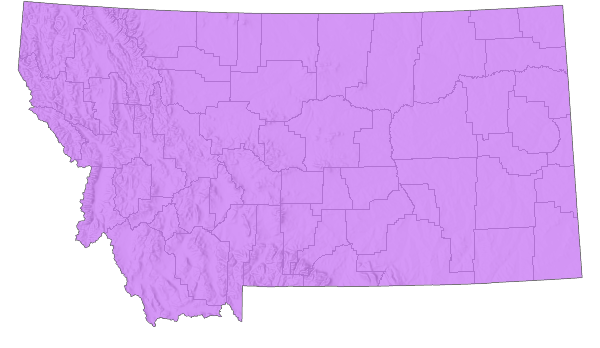
 Native
Native
Range Comments
Throughout much of the intermountain West and Rocky Mountain front east of the Cascades and Sierra Nevada crest, from central British Columbia south to central California and east to southern Saskatchewan, the far western Dakotas, northwestern Nebraska, eastern Colorado, central New Mexico (Scott 1986; Opler and Wright 1999; Glassberg 2001); often between 1525 m and 3200 m elevation in Colorado (Brown 1957; Ferris and Brown 1981), between 245 m and 2286 m elevation in Oregon (Warren 2005). In Montana, reported across the state from most counties (Kohler 1980; Stanford and Opler 1993). Common to abundant (Glassberg 2001).
Observations in Montana Natural Heritage Program Database
Number of Observations: 53
(Click on the following maps and charts to see full sized version)
Map Help and Descriptions
Relative Density
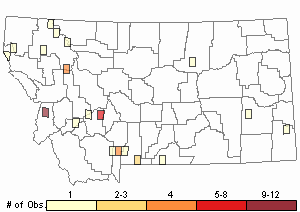
Recency
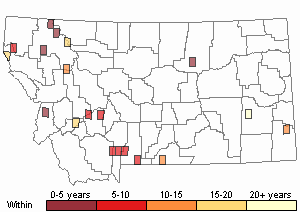
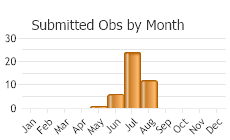
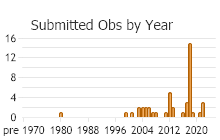
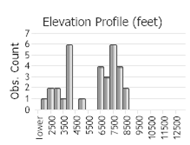 (Observations spanning multiple months or years are excluded from time charts)
(Observations spanning multiple months or years are excluded from time charts)
Migration
Non-migratory.
Habitat
Open arid brushland, chaparral, sagebrush steppe, high plains, foothills, open woodlands, montane meadows, on occasion above treeline in alpine terrain (Ferris and Brown 1981; Scott 1986; Opler and Wright 1999; Glassberg 2001; Guppy and Shepard 2001; Pyle 2002). In Glacier National Park, Montana reported in montane xeric meadows (Debinski 1993); in the Montana portion ot the Greater Yellowstone Ecosystem, most abundant in meadows dominated by sagebrush and grass (Debinski et al. 2013).
Food Habits
Larval food plants include the grasses Festuca and Poa, probably Koeleria; Elytrigia in captivity (Scott 1992; Guppy and Shepard 2001; James and Nunnallee 2011). Adults feed on flower nectar (including Achillea, Anaphalis, Apocynum, Arnica, Berteroa, Ceanothus, Centaurea, Chrysothamnus, Cirsium, Carduus, Clematis, Erigeron, Erioganum, Geranium, Grindelia, Gutierrezia, Heterotheca, Medicago, Melilotus, Mentha, Monarda, Potentilla, Rudbeckia, Senecio, Solidago, Symphyotrichum, Tetradymia, Viguira), mud, dung, and carrion (Pyle 2002; James and Nunnallee 2011; Scott 2014).
Reproductive Characteristics
Females lay eggs (100-150) singly, often on undersides of dried grass blades, in litter, or on nearby plants; 10 cm above ground surface (Emmel 1969; Scott 1986, 1992). Eggs hatch in about 14 days; L1 instars hibernate (overwinter) in groups. Development fairly rapid after breaking diapause, reaching L5 instar and pupation in about 55 days (depending on temperature). Adults eclose (emerge from pupae) in about 18 days. Larvae do not build nest, feed on edges of grass blades mostly at night, are gregarious. Pupae attached to grass stems or blades, adjacent blades pulled down with silk to form slight protective tent; sometimes pupae attached to underside of forb leaf (Emmel 1969; Scott 1979, 1992; James and Nunnallee 2011). Males patrol throughout the day in open and grassy areas, regardless of topography, seeking females (Scott 1975b, 1986).
Stewardship Responsibility
References
- Literature Cited AboveLegend:
 View Online Publication
View Online Publication Brown, F.M. 1957. Colorado Butterflies. Proceedings; Numbers Three through Seven. Denver Museum of Natural History, Denver, Co.
Brown, F.M. 1957. Colorado Butterflies. Proceedings; Numbers Three through Seven. Denver Museum of Natural History, Denver, Co. Debinski, D. 1993. Butterflies of Glacier National Park, Montana. Occasional Papers of the Museum of Natural History, the University of Kansas, Lawrence, Kansas. No. 159: 1-13.
Debinski, D. 1993. Butterflies of Glacier National Park, Montana. Occasional Papers of the Museum of Natural History, the University of Kansas, Lawrence, Kansas. No. 159: 1-13. Debinski, D.M., J.C. Caruthers, D. Cook, J. Crowley, and H. Wickham. 2013. Gradient-based habitat affinities predict species vulnerability to drought. Ecology 94(5): 1036-1045.
Debinski, D.M., J.C. Caruthers, D. Cook, J. Crowley, and H. Wickham. 2013. Gradient-based habitat affinities predict species vulnerability to drought. Ecology 94(5): 1036-1045. Emmel, T.C. 1969. Taxonomy, distribution and biology of the genus Cercyonis (Satyridae). I. Characteristics of the genus. Journal of the Lepidopterists' Society 23:165-175.
Emmel, T.C. 1969. Taxonomy, distribution and biology of the genus Cercyonis (Satyridae). I. Characteristics of the genus. Journal of the Lepidopterists' Society 23:165-175. Ferris, C.D. and F.M. Brown (eds). 1981. Butterflies of the Rocky Mountains. Univ. of Oklahoma Press. Norman. 442 pp.
Ferris, C.D. and F.M. Brown (eds). 1981. Butterflies of the Rocky Mountains. Univ. of Oklahoma Press. Norman. 442 pp. Glassberg, J. 2001. Butterflies through Binoculars: A Field Guide to the Butterflies of Western North America. Oxford University Press.
Glassberg, J. 2001. Butterflies through Binoculars: A Field Guide to the Butterflies of Western North America. Oxford University Press. Guppy, C.S. and J.H. Shepard. 2001. Butterflies of British Columbia: including western Alberta, southern Yukon, the Alaska Panhandle, Washington, northern Oregon, northern Idaho, northwestern Montana. UBC Press (Vancouver, BC) and Royal British Columbia Museum (Victoria, BC). 414 pp.
Guppy, C.S. and J.H. Shepard. 2001. Butterflies of British Columbia: including western Alberta, southern Yukon, the Alaska Panhandle, Washington, northern Oregon, northern Idaho, northwestern Montana. UBC Press (Vancouver, BC) and Royal British Columbia Museum (Victoria, BC). 414 pp. James, D.G. and D. Nunnallee. 2011. Life histories of Cascadia butterflies. Corvallis, OR: Oregon State University Press. 447 p.
James, D.G. and D. Nunnallee. 2011. Life histories of Cascadia butterflies. Corvallis, OR: Oregon State University Press. 447 p. Kohler, S. 1980. Checklist of Montana Butterflies (Rhopalocera). Journal of the Lepidopterists' Society 34(1): 1-19.
Kohler, S. 1980. Checklist of Montana Butterflies (Rhopalocera). Journal of the Lepidopterists' Society 34(1): 1-19. Opler, P.A. and A.B. Wright. 1999. A field guide to western butterflies. Second edition. Peterson Field Guides. Houghton Mifflin Company, Boston, Massachusetts. 540 pp.
Opler, P.A. and A.B. Wright. 1999. A field guide to western butterflies. Second edition. Peterson Field Guides. Houghton Mifflin Company, Boston, Massachusetts. 540 pp. Pyle, R.M. 2002. The butterflies of Cascadia: a field guide to all the species of Washington, Oregon, and surrounding territories. Seattle Audubon Society, Seattle, Washington. 420 pp.
Pyle, R.M. 2002. The butterflies of Cascadia: a field guide to all the species of Washington, Oregon, and surrounding territories. Seattle Audubon Society, Seattle, Washington. 420 pp. Scott, J.A. 1975b. Mate-locating behavior of western North American butterflies. Journal of Research on the Lepidoptera 14:1-40.
Scott, J.A. 1975b. Mate-locating behavior of western North American butterflies. Journal of Research on the Lepidoptera 14:1-40. Scott, J.A. 1979. Hibernal diapause of North American Papilionoidea and Hesperioidea. Journal of Research on the Lepidoptera 18(3): 171-200.
Scott, J.A. 1979. Hibernal diapause of North American Papilionoidea and Hesperioidea. Journal of Research on the Lepidoptera 18(3): 171-200. Scott, J.A. 1986. The butterflies of North America: a natural history and field guide. Stanford University Press, Stanford, California.
Scott, J.A. 1986. The butterflies of North America: a natural history and field guide. Stanford University Press, Stanford, California. Scott, J.A. 1992. Hostplant records for butterflies and skippers (mostly from Colorado) 1959-1992, with new life histories and notes on oviposition, immatures, and ecology. Papilio new series #6. 185 p.
Scott, J.A. 1992. Hostplant records for butterflies and skippers (mostly from Colorado) 1959-1992, with new life histories and notes on oviposition, immatures, and ecology. Papilio new series #6. 185 p. Stanford, R.E. and P.A. Opler. 1993. Atlas of western USA butterflies: including adjacent parts of Canada and Mexico. Unpubl. Report. Denver and Fort Collins, Colorado 275 pp.
Stanford, R.E. and P.A. Opler. 1993. Atlas of western USA butterflies: including adjacent parts of Canada and Mexico. Unpubl. Report. Denver and Fort Collins, Colorado 275 pp. Warren, A.D. 2005. Lepidoptera of North America 6: Butterflies of Oregon, their taxonomy, distribution, and biology. Contributions of the C. P. Gillette Museum of Arthropod Diversity, Colorado State University. Fort Collins, Colorado. 406 pp.
Warren, A.D. 2005. Lepidoptera of North America 6: Butterflies of Oregon, their taxonomy, distribution, and biology. Contributions of the C. P. Gillette Museum of Arthropod Diversity, Colorado State University. Fort Collins, Colorado. 406 pp.
- Additional ReferencesLegend:
 View Online Publication
View Online Publication
Do you know of a citation we're missing? Allen, T.J., J.P. Brock, and J. Glassberg. 2005. Caterpillars in the field and garden: a field guide to the butterfly caterpillars of North America. Oxford University Press.
Allen, T.J., J.P. Brock, and J. Glassberg. 2005. Caterpillars in the field and garden: a field guide to the butterfly caterpillars of North America. Oxford University Press. Brock, J.P. and K. Kaufman. 2003. Kaufman Field Guide to Butterflies of North America. Houghton Mifflin Company, New York, NY 284 pp.
Brock, J.P. and K. Kaufman. 2003. Kaufman Field Guide to Butterflies of North America. Houghton Mifflin Company, New York, NY 284 pp. Caruthers, J.C., and D. Debinski. 2006. Montane meadow butterfly species distributions in the Greater Yellowstone Ecosystem. University of Wyoming National Park Service Research Center Annual Report, 2006. Vol. 30, Art. 14. 85-96.
Caruthers, J.C., and D. Debinski. 2006. Montane meadow butterfly species distributions in the Greater Yellowstone Ecosystem. University of Wyoming National Park Service Research Center Annual Report, 2006. Vol. 30, Art. 14. 85-96. Debinski, D.M., R.E. VanNimwegen, and M.E. Jakubauskas. 2006. Quantifying relationships between bird and butterfly community shifts and environmental change. Ecological Applications 16(1): 380-393.
Debinski, D.M., R.E. VanNimwegen, and M.E. Jakubauskas. 2006. Quantifying relationships between bird and butterfly community shifts and environmental change. Ecological Applications 16(1): 380-393. Forister, M.L., C.A. Halsch, C.C. Nice, J.A. Fordyce, T.E. Dilts, J.C. Oliver, K.L. Prudic, A.M. Shapiro, J.K. Wilson, J. Glassberg. 2021. Fewer butterflies seen by community scientists across the warming and drying landscapes of the American West. Science 371:1042-1045.
Forister, M.L., C.A. Halsch, C.C. Nice, J.A. Fordyce, T.E. Dilts, J.C. Oliver, K.L. Prudic, A.M. Shapiro, J.K. Wilson, J. Glassberg. 2021. Fewer butterflies seen by community scientists across the warming and drying landscapes of the American West. Science 371:1042-1045. Forister, M.L., E.M. Grames, C.A. Halsch, K.J. Burls, C.F. Carroll, K.L. Bell, J.P. Jahner, et al. 2023. Assessing risk for butterflies in the context of climate change, demographic uncertainty, and heterogeneous data sources. Ecological Monographs 93(3):e1584. https://doi.org/10.1002/ecm.1584
Forister, M.L., E.M. Grames, C.A. Halsch, K.J. Burls, C.F. Carroll, K.L. Bell, J.P. Jahner, et al. 2023. Assessing risk for butterflies in the context of climate change, demographic uncertainty, and heterogeneous data sources. Ecological Monographs 93(3):e1584. https://doi.org/10.1002/ecm.1584 Hendricks, P. and M. Roedel. 2001. A faunal survey of the Centennial Valley Sandhills, Beaverhead County, Montana. Report to the U.S. Bureau of Land Management and U.S. Fish and Wildlife Service. Montana Natural Heritage Program, Helena, MT. 44 p.
Hendricks, P. and M. Roedel. 2001. A faunal survey of the Centennial Valley Sandhills, Beaverhead County, Montana. Report to the U.S. Bureau of Land Management and U.S. Fish and Wildlife Service. Montana Natural Heritage Program, Helena, MT. 44 p. Layberry, R.A., P.W. Hall, and J.D. LaFontaine. 1998. The Butterflies of Canada. University of Toronto Press. 280 pp. + color plates.
Layberry, R.A., P.W. Hall, and J.D. LaFontaine. 1998. The Butterflies of Canada. University of Toronto Press. 280 pp. + color plates.
- Web Search Engines for Articles on "Small Wood-nymph"
- Additional Sources of Information Related to "Insects"





